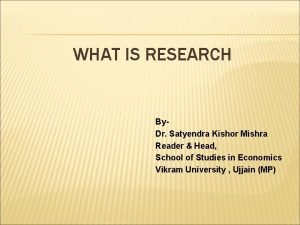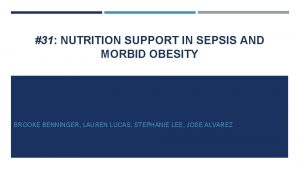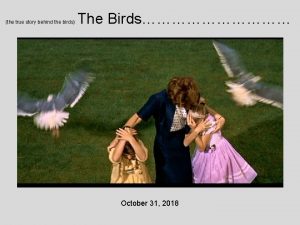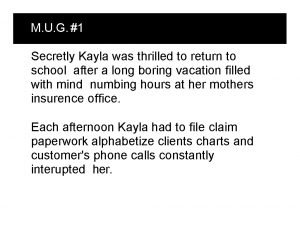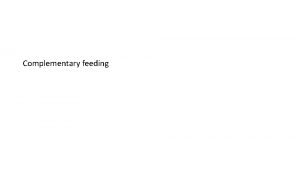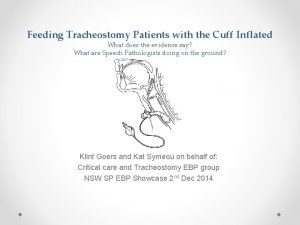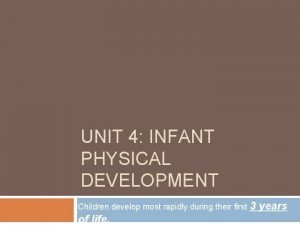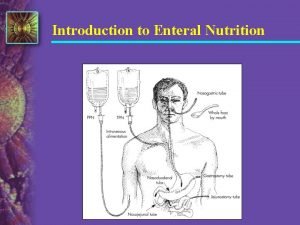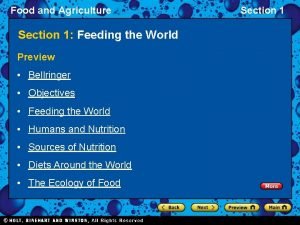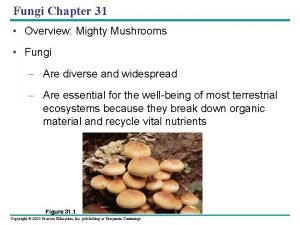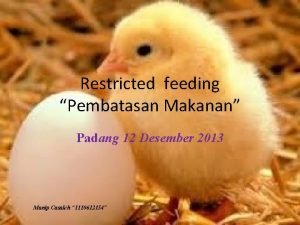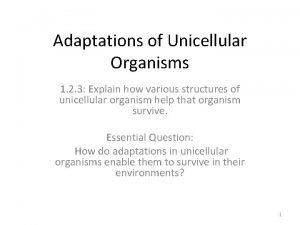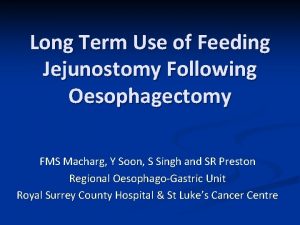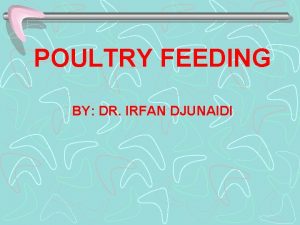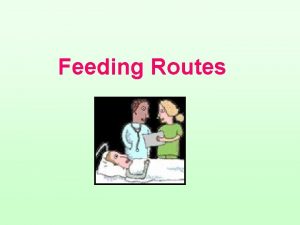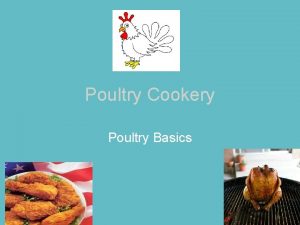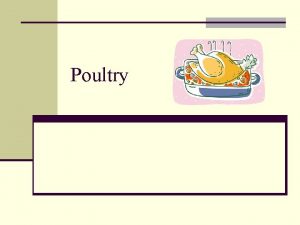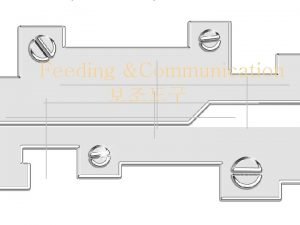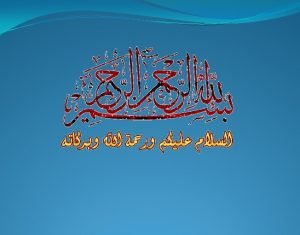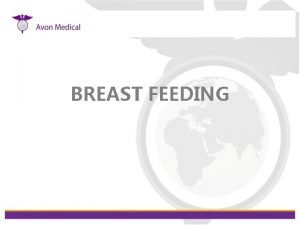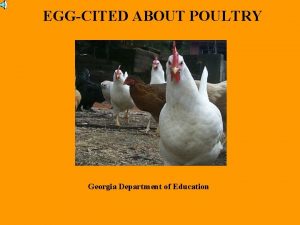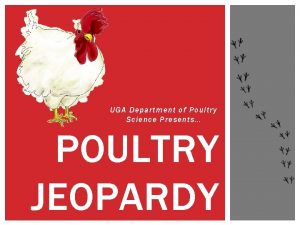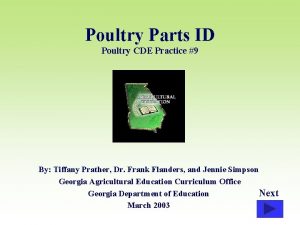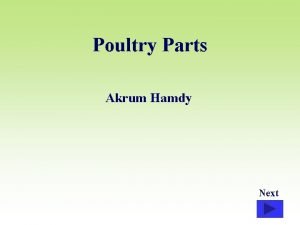FEEDING OF POULTRY Dr Amrendra Kishor Department of


















- Slides: 18

FEEDING OF POULTRY Dr. Amrendra Kishor Department of LPM Bihar Veterinary College, Patna- 800 014

FEEDING OF POULTRY • Feeding of poultry accounts for the 60 -70% of the total expenditure on poultry production. • The quality of feed and methods of feeding are important for efficient poultry production. While feeding birds, the following features should be kept in mind: ØSimple stomach unlike ruminants. ØDue to absence of teeth, feed particles grinded to 710 mµ. ØNutrient levels in the diet: altered as per the season. ØShort digestion time (4 hrs) demands high quality feed. ØImbalanced nutrition may lead to metabolic disorders and nutrient deficiency diseases.

Major nutrient required by the poultry • Water, carbohydrate, protein, fats, vitamins and minerals. • Principal energy source: carbohydrate and fat. • Fats are concentrated form of energy and yield 2. 25 times more energy than CHO. • Fats are also source of essential fatty acids viz. linolenic acid, linoleic acid and arachidonic acid. • Proteins are essential for requirement of amino acids like nonessential and essential amino acids. Essential amino acids (AVGMPHILLTT) must be supplied in the diet. • Critical amino acids: arginine, lysine, methionine, cystine and tryptophan – must be supplied in diet. • Vitamins and minerals: non-energy source but necessary for regulating the metabolic processes in the body.

Poultry feed ingredients 1. Energy feedstuffs: Cereals unfit for human consumption, agro -industrial byproducts to manufacture feed of desired energy level and cheaper rations. • Maize is the principal energy feedstuff, highly palatable and rich source of energy. • Yellow variety preferred over red variety due to high carotene and xanthophylls pigment responsible for yellow colouration of yolk. • Jowar, bajra and other millets such as ragi are also good source of energy but contain bitter substances – tannins. • Barley and oats are high in fiber and can be used in grower and breeder feeding. • Wheat and rice polish (pericarp) are rich in B-complex vitamins.

• Damaged wheat and rice grains, spoiled due to rain and pest during storage in ware houses, are also used as energy feedstuffs in formulating poultry rations. • Molasses is rich in energy and reduces dustiness and can be included up to 4– 8 per cent. High inclusion: loose droppings. 2. Protein feedstuffs: i. Vegetable protein feedstuffs : These includes groundnut cake, soybean meal, sunflower meal, sesame meal, cotton seed cake, maize gluten meal, linseed cake, yeast (distillery and brewery industry – rich in vit. B-complex), Penicillium mycelium (residual antibiotic) etc. • Common protein feedstuffs are deficient in lysine and methionine. ii. Animal protein feedstuffs: Fish meal (< 3% salt), meat meal, blood meal, bone and feather meal (2 -2. 5: 5), and hatchery

3. Unconventional feedstuffs : Mango seed kernels, Lucerne and berseem meal (high in carotene, 3– 5%), alfalfa meal (high in vit- A). • Ever increasing prices and competition with human being for conventional feed ingredients makes it imperative to search newer non-conventional feedstuffs for poultry feeding. 4. Mineral and vitamin supplements: Common salt, oyster shell (grit), lime stone, Dicalcium phosphate (DCP), steamed bone meal, ready to use commercial mineral mixtures. • Too much salt will result in increased water consumption and wet droppings. • Part of vitamin requirement comes from feed ingredients and vitamin mixtures. • 3 -8% fats are included in poultry ration. • Fat rancidity is prevented by inclusion of 0. 02% antioxidant (BHT, BHA, Ethoxyquin).

General principles for feed formulation 1. All essential nutrients should be in adequate quantity. 2. Feed should be free from bacterial contamination. 3. Type of ration to be prepared depending on species and breed and purpose of rearing. 4. Decision regarding energy and protein content of the diet based on the requirement tables. 5. Trace mineral mix. and vit. premix added as per recommendation. 6. Common salt should be added @ 0. 5% of the ration. 7. All the ingredients should be mixed thoroughly. 8. Finished feed not be stored for more than 1. 5 months. 9. The diet should be balanced with respect to amino acids. 10. The trace mineral mixture and vitamin premix should be mixed with rice bran before final mixing.

• The relative amounts of both metabolizeable and net energy will vary with the composition of the feedstuffs in the diet. • Species, genetic makeup, environmental conditions and age of poultry also influence the precise distribution of dietary energy into the various compartments.

Nutrient requirements for different classes of poultry Type of birds CP (%) ME(Kcal/kg) Ca (%) P (%) Layer chicks 22 2700 1 0. 5 Growers 16 2600 1 0. 5 Layers 18 2700 2. 75 0. 5 Broiler starter 22 2900 1 0. 5 Broiler finisher 19 3000 1 0. 5

Ideal Rations for poultry Ingredient (%) Layer starter Grower ration Layers Broiler starter Broiler finisher Maize, yellow 28 27 35 45 48 Rice polish 34 45 34 11 18 Lucerne meal 3 3 3 1 1 GNC 22 15 17. 5 29 21 Fish meal 10 7 6 11 9 Lime stone 1. 5 3 1. 5 Bone meal 1 1 1 Common salt 0. 5 0. 5 Cal: Protein 139 -145 169 -189 185 -191 132 -143 152 -165

Anti-nutritional factors in feed stuffs and their effects on poultry performance Feedstuffs Antinational factor Adverse effects Sorghum Tannins Inhibitory to growth Castor seed cake Ricin Purgative Cotton seed cake Gossypol Olive coloured egg yolk Groundnut cake Alfa toxin Aflatoxicosis Linseed cake Prussic acid Toxic factor Soybean cake Soyin Trypsin inhibitor

Common methods of feeding poultry 1. Grain and mash feeding: Feeding of grain/grain mixture along with balanced mash. Layers get a mixture of cereal grains and minerals, protein and vitamins supplements in the form of mash. 2. All mash feeding: All the ingredients are ground and mixed in required proportion. The birds do not have choice o selecting any ingredient. Hence, the eggs produced are of uniform quality. 3. Pellet feeding: Dry mash is pelleted under high pressure. The advantages of pellet feeding includes saving of 15 -20% the feed required. • It is convenient, reduced labours and handling cost. Feed wastage is reduced. 4. Crumble feeding: Produced by rolling pellets. • Cost slightly more, reduce feed wastage & sorting, adapted to automatic equipment, less feeder and storage space, and improve palatability.

5. Controlled/Restricted feeding: In this method the production cycle is divided into three phases: Phase I: This is the critical period of 22– 42 weeks. The birds are expected to reach from zero to peak egg production of 85%. • This is accompanied into increase in body weight by 500 gram and egg size by 40 g to 60 g. The calorie protein ratio of the ration should be so adjusted depending upon the protein required and the feed consumed. In winter, calorie protein ratio should range 160 -170 and it may be reduced to 150– 155 in summer. Phase II: It ranges from 42– 62 weeks of age. The calorie protein ratio in winter should be 193– 195 and about 10% lower in summer. Phase III: It ranges from 62– 72 weeks of age till the spent out birds are discarded. The protein requirement (15 g/hen/day) could be met if calorie protein ratio is kept 196 -200 in winter and 175180 in summer months.

Other methods of feed restriction are: • Limited feeding time • Quantitative restriction • Qualitative restriction • Nutrient dilution • Skip-a-day feeding • Elevation of environmental temp. Precautions to be taken during feeding • Feeders should be stirred frequently and scarped periodically to avoid cake formation due to fungus and mould growth. • Feeders should be filled 1/3 rd to ½ level to control feed wastage. • Under and over feeding should be avoided.

Feeding management of poultry • Saving feed cost and reducing the cost of poultry production. 1. Feed restriction: delaying sexual maturity by controlling weight and increasing egg production and production life of layers. 2. Nutritional adjustment during extreme weather: 13 -18 o. C • Above 30 o. C: Not eat to meet the energy requirement. • Below 13 o. C: Overconsume the energy. • Both extremes result in increased cost of poultry meat and egg production 3. Reducing stress and diseases: Poor feed efficiency • Subclinical disease is economically more dangerous because sik birds consume feed without efficient production

Feeding of Broilers • Broilers are fed ad-libitum as the growth is very fast in broilers. • The broilers ration is high in energy and protein. • Broiler starter ration is fed for 3 weeks and broiler finisher thereafter till market age. Feeding of Layers • Layers are maintained on controlled feeding to avoid fat deposition. • Feed daily a controlled amount of a well-balanced diet. • Provide adequate feeder space and a rapid even distribution of the feed. • Supplement 2% or more Ca in the diet for egg shell formation. • Higher concentrations of vitamins (A, D, E, riboflavin, pantothenic acid, niacin, and. B 12) and Mn & Zn required hatching eggs.

Nutritional deficiency diseases • Deficiency is caused due to dietary insufficiency or inactivation of nutrient components. • Continuous non-supply of nutrients causes deficiency. • Symptoms are non-infectious, reversible, uneven growth, improper growth of feathers, low hatchability, drop in egg production, low FCR, immune suppression, increased susceptibility to diseases. • Any nutrient in excess will cause toxicity e. g. Ca- nephritis; Excess fat increases abdominal fat (Fatty liver– kidney syndrome), excess protein- Gout. • Excess salt in diet results in salt poisoning and excess vitamin- E interferes with nutrient absorption. • Feed ingredients carry toxins as mycotoxins, insecticides and antibiotics causing liver and kidney damage.

Nutritional deficiency diseases Nutrients Vitamin – A Symptoms Retarded growth, weakness, nutritional roup, pustules in mouth, reduced egg production, impaired vision. Vitamin- D Soft bones, leg deformity, lameness, swollen joints, rickets, poor egg production, soft shelled eggs. Vitamin – E Crazy chick disease (encephalomalacia) exudative diathesis. Vitamin – K Hemorrhages in subcutaneous tissues, thigh and breast muscles. Vitamin – B 1 Loss of appetite, polyneuritis. Vitamin – B 2 Curled toe paralysis, reduced growth emaciation, weakness. Chohne Retarded growth and slipped tendon, swelling of hock joint. Calcium Rickets, thin shelled eggs, drop in egg production, cage layer fatigue. Phosphorus Rickets, osteomalacia, loss of appetite and weakness. Manganese Perosis, slipped tendon, dwarfing of long bones.
 Satyender kishor
Satyender kishor Rashtriya kishor swasthya karyakram
Rashtriya kishor swasthya karyakram Continuous feeding vs bolus feeding
Continuous feeding vs bolus feeding In a ∆-connected source feeding a y-connected load
In a ∆-connected source feeding a y-connected load Oral placement therapy
Oral placement therapy Tube feeding diet menu
Tube feeding diet menu Suspension feeding
Suspension feeding Mt washington pediatric hospital feeding clinic
Mt washington pediatric hospital feeding clinic Community ecology
Community ecology At the halloween dance the catering committee
At the halloween dance the catering committee Principle of complementary feeding
Principle of complementary feeding Cuff inflated tracheostomy
Cuff inflated tracheostomy Self feeding
Self feeding Decanted formula
Decanted formula Section 1 feeding the world
Section 1 feeding the world Suspension feeding
Suspension feeding Restricted feeding
Restricted feeding Paramecium feeding
Paramecium feeding Feeding jejunostomy diet chart
Feeding jejunostomy diet chart
